“The Black Nazarene is a life-sized iconic statue of Jesus Christ enshrined in the Quiapo district of the City of Manila, Philippines. The image, which was carved by an anonymous Mexican artist sometime in the 17th century, depicts Jesus bearing the cross en route to his crucifixion. The statue is renowned in the Philippines and considered miraculous by many Filipino Catholics. Every January 9, the Traslación of the Black Nazarene makes its way along the streets of the Quiapo district, with attendees reaching up to 12 million. In recent years, the processional route was altered due to a rise in vehicular and stampede accidents, to afford other neighbourhoods off the traditional route a chance to participate, and because of structural deficiencies in bridges along the route. It is normally only a school holiday for the schools along or near the path of the procession, but in 2014 the Mayor of Manila and former President Joseph Estrada, for the first time in the city's history, declared it a special non-working holiday due to the impassability of some thoroughfares and projected congestion in others. As per custom, the statue of the Nazarene leaves the Minor Basilica a day or two before, either in a public fashion or clandestinely.
Since 2007 and 2009, the procession begins at around 08:00 PHT (GMT+8) after a Mass at the Quirino Grandstand in Rizal Park, near where the image was first enshrined, and ends in Quiapo early the following morning or at late night the same day, depending on how long the image is traveling. Some participants choose to wait for the image inside the Minor Basilica to greet it, while most devotees walk throughout the whole processional route. All devotees wear maroon and yellow like the image's garb, and they walk barefoot as both penance and in emulation of Jesus on his way to Golgotha. Authorities estimate that over 500,000 devotees strode barefoot in the 2013 procession, which was attended by 9 million people. Attendees include families of devotees, tourists, and members of devotees' associations throughout the country (marked by their long gonfalone, usually coloured maroon or white and embroidered in gold, all with an icon of the image and the association name in gold or white surrounding it) and overseas”. – Wikipedia
Since 2007 and 2009, the procession begins at around 08:00 PHT (GMT+8) after a Mass at the Quirino Grandstand in Rizal Park, near where the image was first enshrined, and ends in Quiapo early the following morning or at late night the same day, depending on how long the image is traveling. Some participants choose to wait for the image inside the Minor Basilica to greet it, while most devotees walk throughout the whole processional route. All devotees wear maroon and yellow like the image's garb, and they walk barefoot as both penance and in emulation of Jesus on his way to Golgotha. Authorities estimate that over 500,000 devotees strode barefoot in the 2013 procession, which was attended by 9 million people. Attendees include families of devotees, tourists, and members of devotees' associations throughout the country (marked by their long gonfalone, usually coloured maroon or white and embroidered in gold, all with an icon of the image and the association name in gold or white surrounding it) and overseas”. – Wikipedia
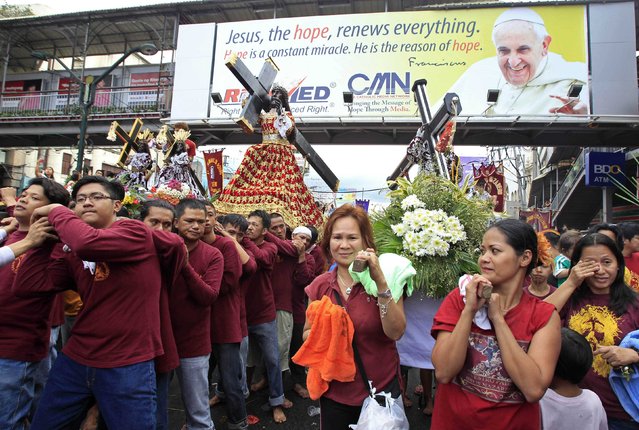
Devotees carrying replica statues of the Black Nazarene walk under a banner of Pope Francis during a procession in Manila January 7, 2015. Millions of devotees are expected to attend the annual procession of the Black Nazarene on Friday. The Black Nazarene, a life-size wooden statue of Jesus Christ carved in Mexico and brought to the Philippines in the 17th century, is believed to have healing powers in the predominantly Roman Catholic country. (Photo by Romeo Ranoco/Reuters)
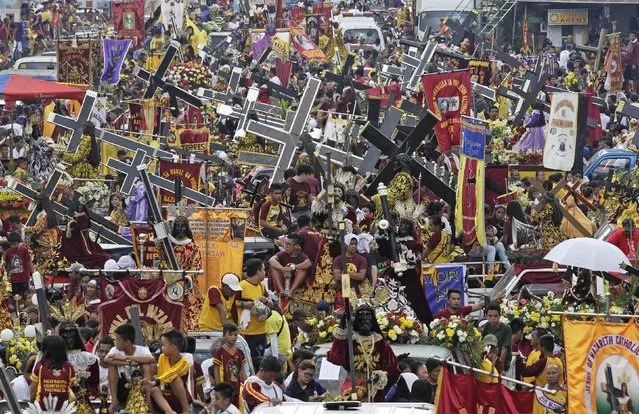
Devotees with replica statues of the Black Nazarene participate in a procession in Manila January 7, 2015. (Photo by Romeo Ranoco/Reuters)
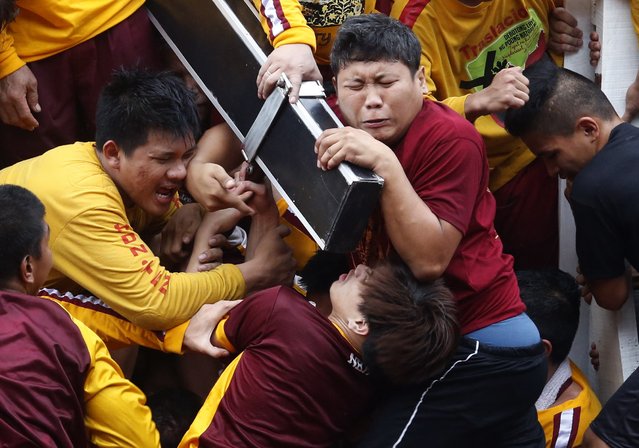
Devotees grimace as they try to hold the Black Nazarene, which is atop a carriage, at the start of an annual procession in Manila, January 9, 2015. More than a million barefoot devotees joined the parade ahead of Pope Francis' visit to the Philippines next week. The Black Nazarene, a life-size wooden statue of Jesus Christ carved in Mexico and brought to the Philippines in the 17th century, is believed to have healing powers in the predominantly Roman Catholic country. (Photo by Erik De Castro/Reuters)
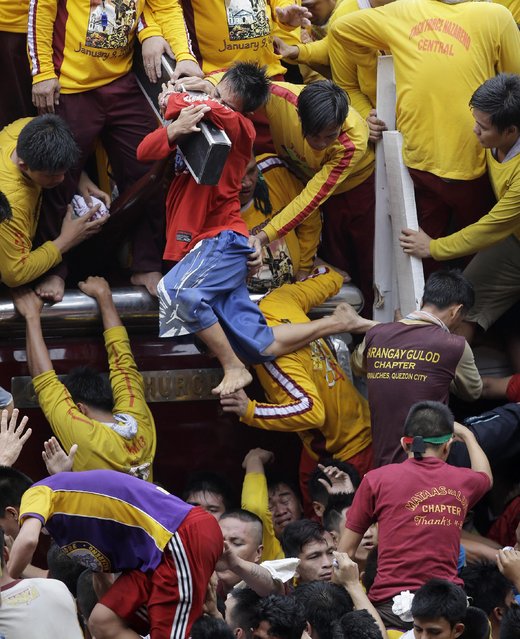
Filipino devotees cling to kiss the cross of the Black Nazarene during a raucous procession to celebrate its feast day Friday, January 9, 2015 in Manila, Philippines. The raucous celebration drew tens of thousands of devotees in a barefoot procession around Manila streets. (Photo by Bullit Marquez/AP Photo)
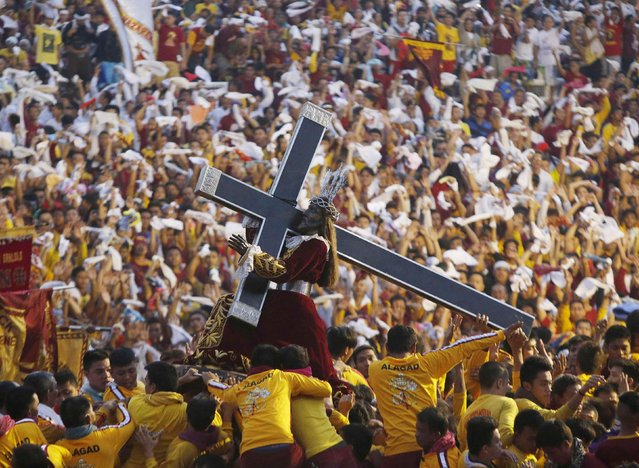
Devotees carry the Black Nazarene at the start of an annual procession in Manila, January 9, 2015. (Photo by Erik De Castro/Reuters)

Devotees wave handkerchiefs as they sing a religious hymn before the start of the annual procession of the Black Nazarene in Manila, January 9, 2015. (Photo by Erik De Castro/Reuters)

Devotees try to hold the Black Nazarene during an annual procession in Manila, January 9, 2015. (Photo by Erik De Castro/Reuters)
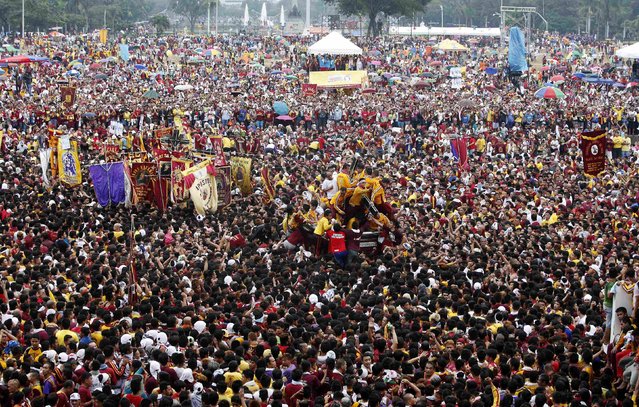
The carriage carrying the Black Nazarene is surrounded by devotees during an annual procession in Manila, January 9, 2015. (Photo by Erik De Castro/Reuters)

A devotee grimaces while holding the Black Nazarene at the start of an annual procession in Manila, January 9, 2015. (Photo by Erik De Castro/Reuters)

Devotees kiss the Black Nazarene at the start of an annual procession in Manila, January 9, 2015. (Photo by Erik De Castro/Reuters)
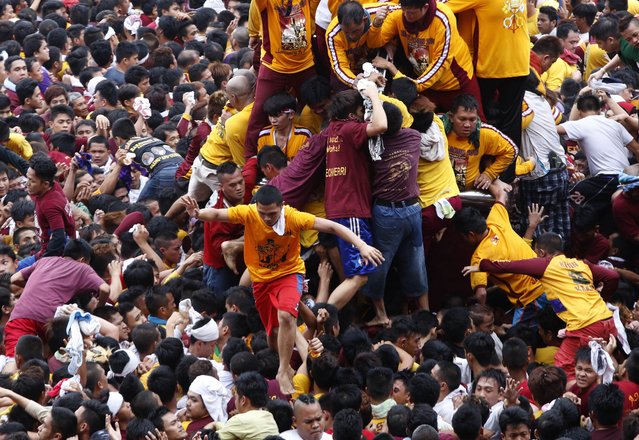
A devotee walks on the shoulders of people after kissing the Black Nazarene at the start of an annual procession in Manila, January 9, 2015. (Photo by Erik De Castro/Reuters)

The carriage carrying the Black Nazarene makes it way through thousands of people as it is pulled by devotees during an annual procession in Manila, January 9, 2015. (Photo by Erik De Castro/Reuters)

Devotees carry the Black Nazarene (R) to be placed on a carriage before an annual procession in Manila, January 9, 2015. (Photo by Erik De Castro/Reuters)
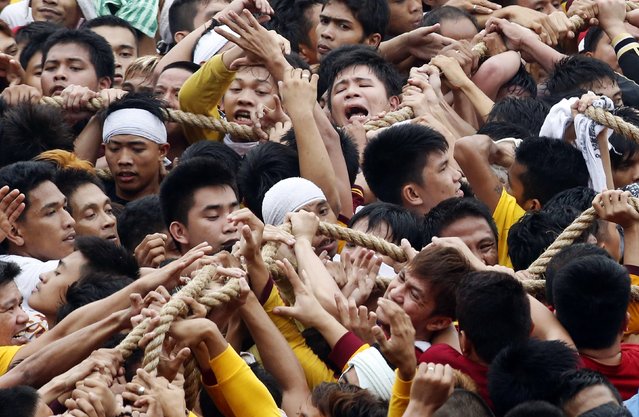
Devotees pull a carriage carrying the Black Nazarene with a rope during the annual procession in Manila, January 9, 2015. (Photo by Erik De Castro/Reuters)
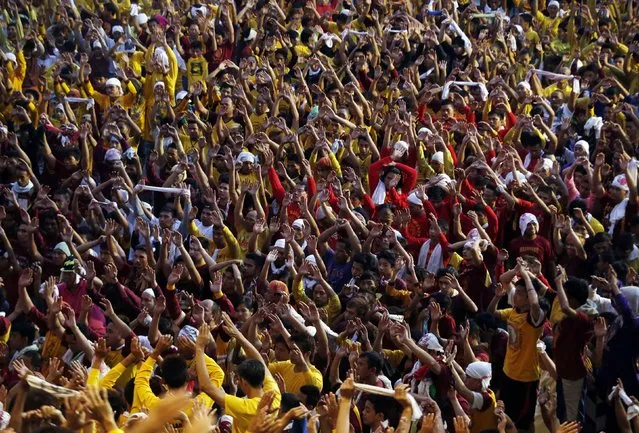
Devotees raise their hands as they pray before the start of the annual procession of the Black Nazarene in Manila, January 9, 2015. (Photo by Erik De Castro/Reuters)

Devotees welcome the Black Nazarene as it is pulled on a carriage toward the entrance of a Catholic church after a 19-hour procession in Manila January 10, 2015. (Photo by Erik De Castro/Reuters)
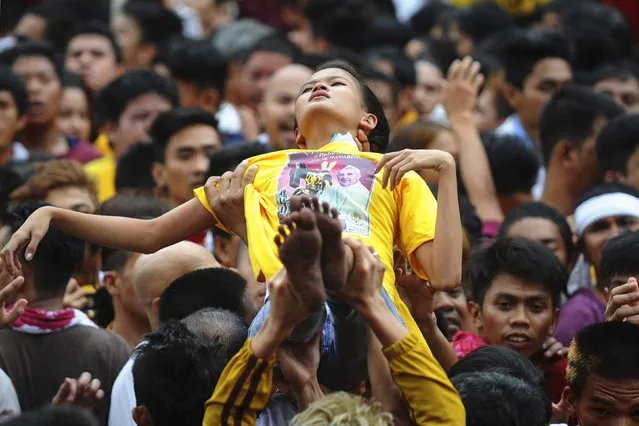
Devotees of the Black Nazarene lifts-up a woman who fainted during an annual procession in Manila January 9, 2015. (Photo by Ezra Acayan/Reuters)
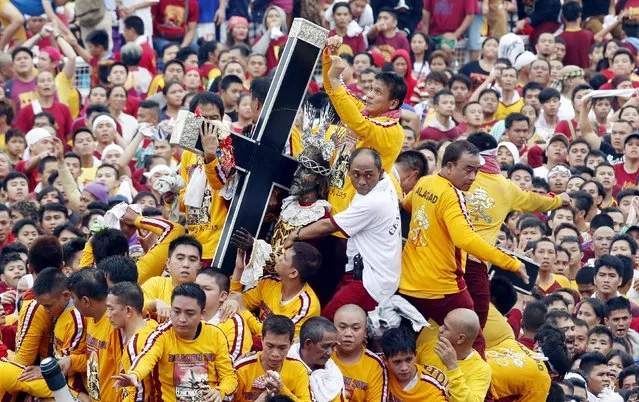
Devotees try to hold the Black Nazarene as it is pulled on a carriage during an annual procession in Manila, January 9, 2015. (Photo by Erik De Castro/Reuters)
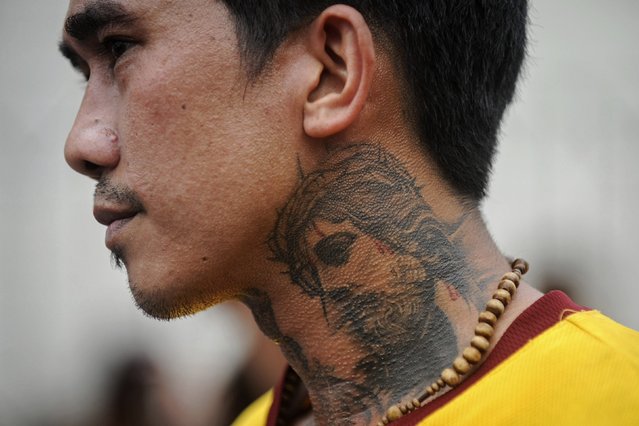
A devotee shows his tattoo image of the Black Nazarene during the annual procession in Manila January 9, 2015. (Photo by Ezra Acayan/Reuters)
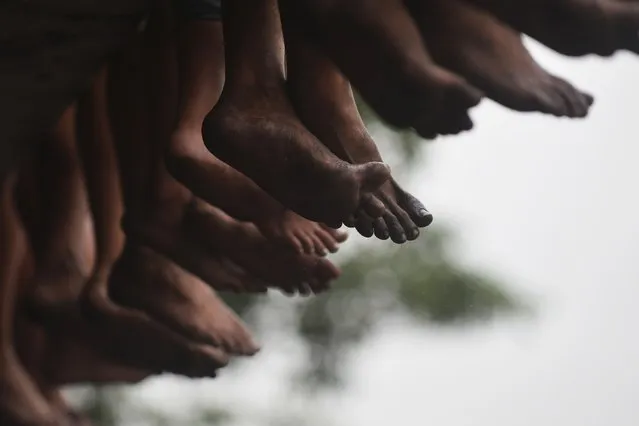
Barefoot devotees sit on top of a pedestrian waiting shed as they wait for the Black Nazarene during the annual procession in Manila January 9, 2015. (Photo by Ezra Acayan/Reuters)
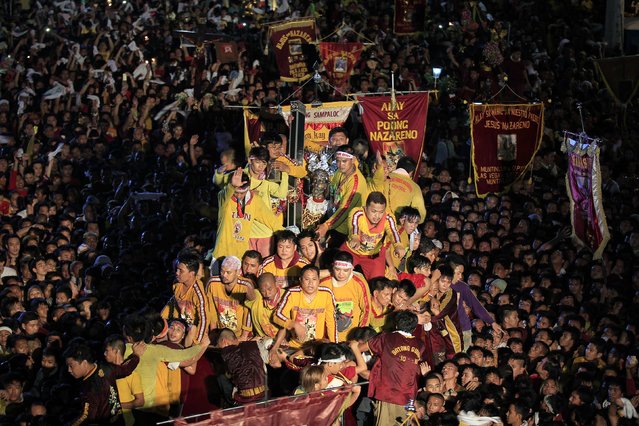
Devotees welcome the Black Nazarene as it is pulled on a carriage toward the entrance of a Catholic church after a 19-hour procession in Manila January 10, 2015. (Photo by Romeo Ranoco/Reuters)
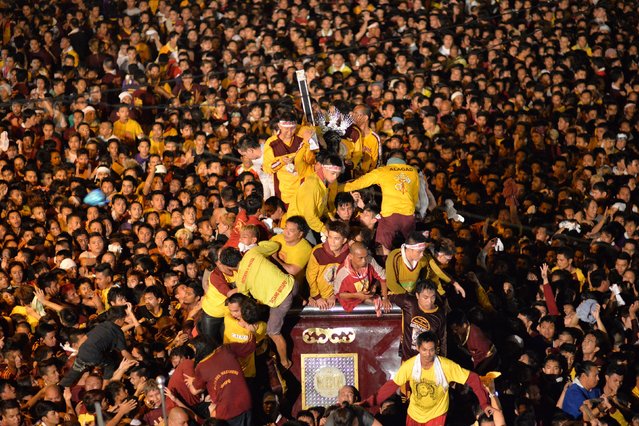
Devotees try to hold the Black Nazarene as it is pulled on a carriage during an annual procession in Manila January 9, 2015. (Photo by Ezra Acayan/Reuters)
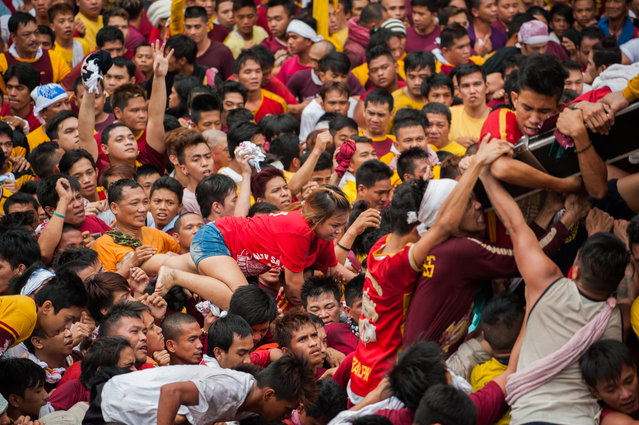
Black Nazarene devotees clamber on top of one another to to touch the cross on January 9, 2015 in Manila, Philippines. The Feast of the Black Nazarene culminates in a day long procession on January 9 as barefoot devotees march to see and touch the image of the Black Nazarene. The Black Nazarene is a dark wood sculpture of Jesus brought to the Philippines in 1606 from Spain and considered miraculous by Filipino devotees. The event falls a week ahead of the visit of Pope Francis who will travel to Leyte and Manila during his visit to the Philippines from January 15–19. The visit is expected to attract crowds in the millions as Filipino Catholics flock to catch a glimpse of the leader of the Catholic Church. The Philippines is the only Catholic majority nation in Asia with around 90 percent of the population professing the faith. (Photo by Dondi Tawatao/Getty Images)
11 Jan 2015 13:46:00,
post received
0 comments
